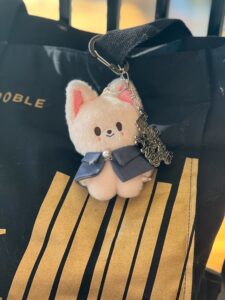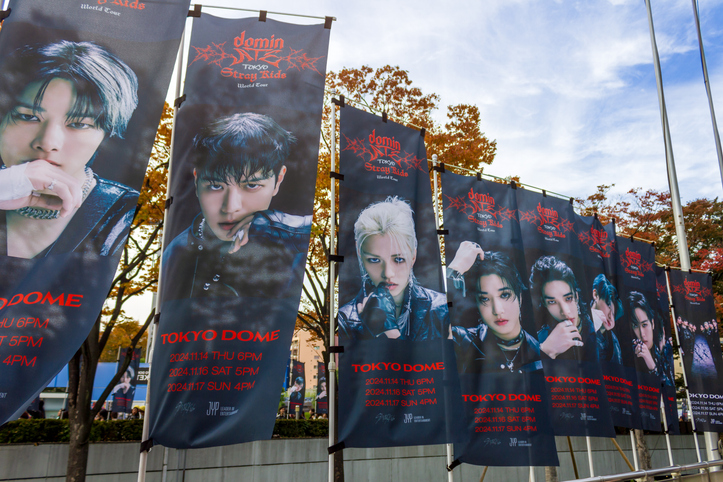EMORY, Va. — On Nov. 18, 2023, I became a K-pop fan.
It’s a date I now think of as lightly ridiculous and completely formative. My college roommate just angled her phone toward me from across the room and said, “Look at Chan’s abs.”
This was not a new ritual. Katie and I long maintained a diplomatic fandom exchange. Our bedroom looked like a split-screen: where my walls were decorated with print-outs of Taylor Swift, 5 Seconds of Summer, and One Direction, and hers were adorned with BTS posters, Stray Kids albums, and Twice concert freebies.
We existed on parallel tracks. We understood each other’s excitement without understanding each other’s fandoms.
The TikTok she showed me that night in our dorm featured two boys dancing— precise, athletic, and cool in a way that doesn’t care if it’s cool.
I hardly registered the one in the crop top.
Katie laughed. “That’s I.N.”
I opened Instagram and followed him immediately. By the end of the next night, I’d texted my friend El — another avid Stray Kids fan — who spent more than an hour on FaceTime introducing me to the members one by one. We went over everything from which songs I should listen to first to the intricacies of each member’s personality. There were eight members. There were stage names and backstories. There was lore.
The First Listen
The feeling was familiar. I knew what the beginning stages of joining a fandom felt like: overwhelming, but in a way that makes you lean in.
But this wasn’t the first time I’d encountered K-pop. Katie had shown me other videos before — I’d watched HAN dancing, heard “Domino” as a trending sound on TikTok, seen selfies of Bang Chan. I thought it was cool, but nothing had invited me in yet.
There’s a term in K-pop: ultimate bias. The one idol who captures your attention and rearranges your fandom DNA. That night, I.N became mine.
What I was feeling wasn’t just attraction. Music played a big part, too. Stray Kids sounded like nothing I’d ever heard before: intense, layered, melodic, sometimes chaotic, but apologetically so. It was theatrical, with high-stakes production engineered to set your heart on fire. It was maximalist in a way that felt addictive rather than excessive.
I’ve always had wide-ranging tastes. I love a good Sabrina Carpenter bridge as much as I love a Muchael Clifford guitar solo — but Stray Kids was different. The music didn’t try to blend in. It asked you to keep up.
I asked Katie, “Why isn’t this more popular here?” But, of course, it is. You just have to know where to look.
The K-Pop Phenomenon
Psy’s “Gangnam Style” became a novelty hit in the U.S. in 2012, and “Dynamite” by BTS completely took over American radio in 2020. But by then, the global fandom had long been thriving.
Outlets like Billboard and Rolling Stone covered BTS’s rise before “Dynamite” hit the airwaves. Last year, Forbes published a piece on how K-pop artists keep CD sales alive in the United States. The Victoria and Albert Museum in London launched an exhibit dedicated to Korean art and K-pop’s cultural influence. YouTube complications of fan reactions go viral. Entire stadiums filled with fans singing in Korean sell out across continents.
K-pop isn’t just having a moment. It’s changing what global fandom means.
To understand the scale of it all, I reached out to Grace Lee, Korean-American filmmaker who has studied the phenomenon up close. Her latest documentary, Forever We Are Young, premiered at SXSW 2025 — a film that dives deep into the BTS fandom and its global resonance.
Lee remembers the days when the only people interested in K-pop in America were Korean-Americans. “If you had told me that as an adult I’d be attending concerts where 50,000 people were singing in Korean, I’d be like, ‘You’re crazy.’ It’s just become so global, so popular in general these days,” she said.
K-Pop in Country Music County
When I became a fan, I lived about thirty minutes from Bristol, Tenn., the birthplace of country music. Around here, music means honky-tonk bars and Southern rock cover bands. It’s the kind of music meant for drinking whiskey and two-stepping. There are Top 40 stations, sure, but genre diversity is sparse, and K-pop is nearly invisible. Or so I thought.
Once I was in the fandom, I started seeing K-pop everywhere.

The SKZOO character FoxI.Ny. [Photo Credit: Cait Barker]
They weren’t just coincidences. They were signs, and I had learned how to read them. I had found a secret community that had been sitting next to me all along.
Now, I carry my own SKZOO keychain, a little fox character named FoxI.Ny, clipped on my everyday bag. It’s a tiny code with the potential to open entirely new friendships.
Connections That Span Continents
A mutual friend decided that, despite having absolutely nothing in common on paper, Florence Eng and I needed to talk. Florence is a BTS fan living in New York City, with kids my age. We met over the phone for what was supposed to be a short interview, and within minutes, I understood why we’d been set up on this platonic fandom blind date.
We talked for over an hour. It wasn’t a dramatic conversation. It was easy, one that stretched beyond K-pop itself. It was about connections that transcend distance and language.
Florence became a BTS fan in 2020, in the early stages of the pandemic when all she had to do was work from home and grapple with the state of the world. Her kids were into K-pop first.
“We were just trading hobbies between ourselves,” Florence said about discovering the joy in listening to K-pop. “Rewatching old BTS music videos just made me happy. And that was it.”
We talked about our favorite groups and members, about the endless flow of content from K-pop groups, and about how, despite our completely different lives, we had both fallen into this world for the same reasons: comfort, curiosity, and joy.
I’ve always known fandoms can be powerful. I’ve spent my life staying up for album drops, overanalyzing lyrics, and rewatching old music videos for Easter eggs. K-pop was no different, and possibly even more intense. It makes you fluent in a language beyond the music.
The Road Ahead
A year into being a K-pop fan, I haven’t left the artists I loved before. I still listen to Taylor Swift. I still revisit One Direction albums. I still brave Ticketmaster for 5 Seconds of Summer tickets.
Some things don’t change. Instead, they just keep expanding.
Everyone I know has a different K-pop entry point. El, my friend who first taught me the members’ names, credits the “anime to K-pop pipeline.” Katie discovered BTS in middle school study hall. This summer, the three of us are driving around 300 miles to see Stray Kids in Atlanta.
Despite the long travel, we’ll get there knowing that tens of thousands of fans all have their own stories about why they love K-pop. And there we will be, all in one place, sharing the same experience together.
When you love something deeply, it becomes a way of being seen. K-pop gave me new music, yes, but also new friendships, new vocabulary, new rituals. It doesn’t care about time, distance, or culture. It makes space for screaming, crying, overanalyzing, and, overall, connection.
I.N was the spark. What came after was a chorus of people — near and far, loud and quiet — reminding me that I was never fangirling alone.


